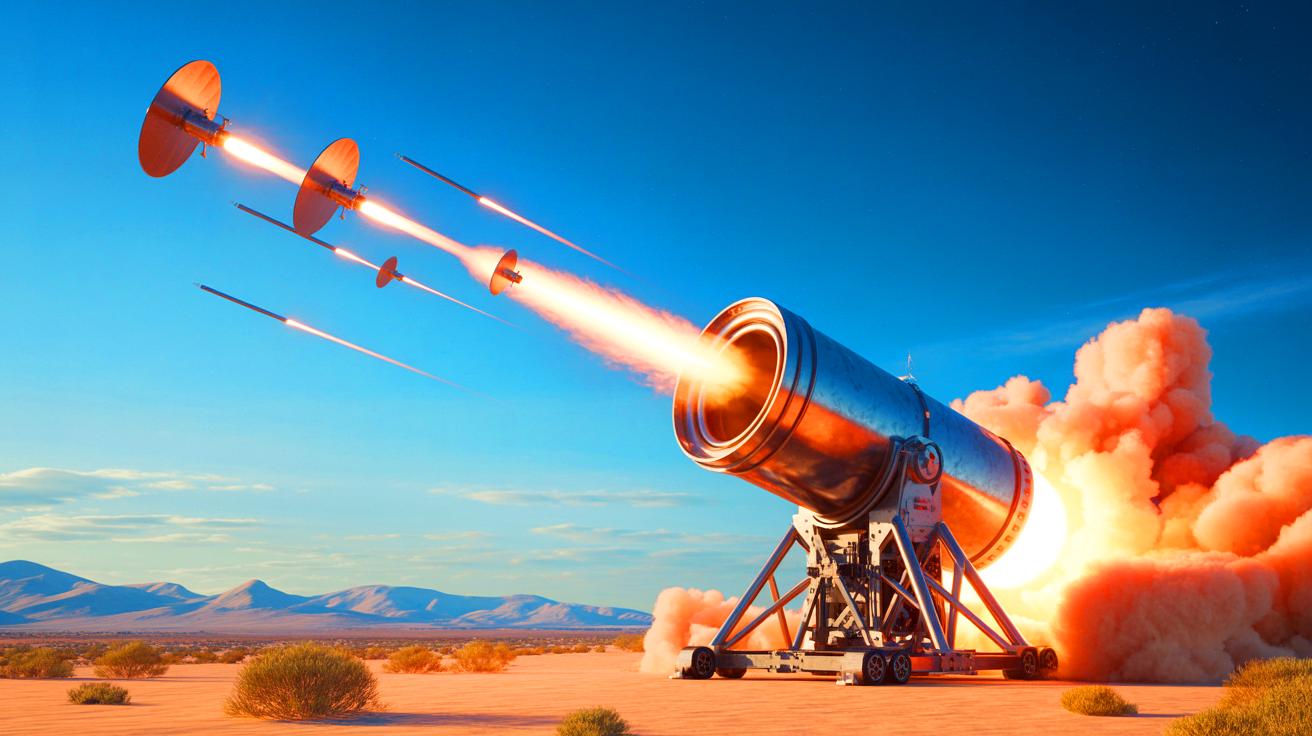| IN A NUTSHELL |
|
SpinLaunch, a trailblazing startup hailing from California, is poised to transform the world of satellite launches. By employing a giant centrifugal cannon, the company aims to send hundreds of flattened “microsatellites” into low-Earth orbit. This innovative method promises to make satellite deployment more cost-effective and environmentally sustainable, positioning SpinLaunch as a formidable contender against industry giants like SpaceX. With substantial funding backing their efforts, SpinLaunch’s approach could set a new benchmark in satellite launches, both in terms of efficiency and ecological impact. The coming years may well witness a shift in how space missions are executed, thanks to this revolutionary technology.
A New Era of Satellite Launches
SpinLaunch’s approach to satellite deployment leverages a massive centrifugal cannon, a groundbreaking concept that could redefine the satellite launch industry. This technology not only aims to reduce costs significantly but also to minimize the environmental footprint traditionally associated with rocket launches. The company’s Meridian Space constellation is at the forefront of this innovation, with plans to launch its first set of pancake-like satellites in the near future. Each microsatellite, measuring 7.5 feet in width and weighing around 154 pounds, is designed to be lighter and more efficient than current alternatives. This method of stacking satellites like pancakes in a “launch bus” could allow SpinLaunch to surpass existing records for simultaneous launches, challenging SpaceX’s dominance.
Backed by nearly $150 million in funding, SpinLaunch’s vision is supported by both investors and industry partners. The recent investment of $12 million from Kongsberg Defence and Aerospace (KDA) underscores the confidence in SpinLaunch’s technology. KDA’s NanoAvionics is tasked with building the initial batch of 250 satellites, further solidifying the project’s credibility. With a launch planned for 2026, SpinLaunch is well-positioned to make a significant impact on the satellite industry.
“They’re burying deadly heat under our feet”: Experts Warn AUKUS Submarines Could Leave Australia With Centuries of Nuclear Waste Risk
The Revolutionary Launch System
Central to SpinLaunch’s innovation is its unique launch system, which utilizes a vacuum-sealed chamber and spinning arms to catapult payloads into space. Known as the Suborbital Accelerator, this technology has already demonstrated its potential by successfully launching 10 rockets into suborbital flight from New Mexico. During these test flights, objects are spun up to speeds of 5,000 mph, enduring forces up to 10,000 Gs before being released into the upper atmosphere. The success of these tests, particularly the most recent one in September 2022, lays a robust foundation for the forthcoming orbital demonstration.
The primary advantage of SpinLaunch’s system is its cost-efficiency. Projected costs for future commercial launches range from $1,250 to $2,500 per kilogram, which is less than half the cost of SpaceX’s Falcon 9 rockets. Additionally, the absence of greenhouse gas emissions and booster rockets during launches contributes to a more sustainable model for space travel. This reduction in environmental impact and space debris could position SpinLaunch as a leader in eco-friendly satellite deployment.
“They lifted off from a road”: Electra’s Hybrid-Electric STOL Jet Stuns Crowd With Ultra-Short Takeoff in Virginia Tech Public Tests
Implications for the Satellite Industry
The introduction of SpinLaunch’s technology could have profound implications for the satellite industry. By providing an affordable and environmentally conscious launch alternative, SpinLaunch is set to challenge established players and alter the competitive landscape. The Meridian Space constellation aims to deliver high-speed communication services at a more accessible price point, potentially democratizing access to space-based services.
SpinLaunch’s ambition extends beyond individual launches, with plans to enhance their capabilities through a larger Orbital Accelerator. This development could enable the company to launch up to five commercial payloads daily, significantly increasing the frequency and accessibility of satellite launches. However, with increased activity in low-Earth orbit comes potential challenges, such as the risk of spacecraft collisions, light pollution, and interference with astronomical observations. Addressing these concerns will be crucial as SpinLaunch moves forward with its plans.
“They’re lighting cities with atom fire”: Trump’s Nuclear Reactor Push Selects 11 Projects to Fast-Track America’s Energy Dominance
Looking Ahead: Challenges and Opportunities
While SpinLaunch’s innovations present exciting opportunities, they also bring challenges that must be carefully navigated. The increase in satellite activity in low-Earth orbit could exacerbate issues such as space debris and atmospheric pollution from re-entering spacecraft. As SpinLaunch advances its ambitious plans, it is crucial to consider these factors and work towards sustainable solutions that balance growth with responsibility.
The success of SpinLaunch’s upcoming launches could establish a new standard for satellite deployment, offering a glimpse into a more accessible and sustainable future for space exploration. However, the question remains: how will the satellite industry adapt to these changes, and what measures will be taken to mitigate the potential risks associated with increased activity in low-Earth orbit?
This article is based on verified sources and supported by editorial technologies.
Did you like it? 4.5/5 (22)



